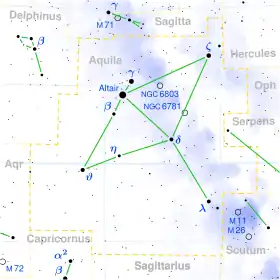Nu Aquilae
Nu Aquilae (ν Aql, ν Aquilae) is the Bayer designation for a double star in the constellation of Aquila and lies close to the celestial equator. It has an apparent visual magnitude of 4.72 and so is visible to the naked eye. Should not be messed up with unrelated star NU Aquilae.
 | |
| Observation data Epoch J2000 Equinox J2000 | |
|---|---|
| Constellation | Aquila |
| Right ascension | 19h 26m 31.09000s[1] |
| Declination | +00° 20′ 18.8521″[1] |
| Apparent magnitude (V) | 4.72[2] + 9.6[3] |
| Characteristics | |
| Spectral type | F3 Ib[4] + A1 IV/V[3] |
| U−B color index | +0.60[2] |
| B−V color index | +0.59[2] |
| Astrometry | |
| Radial velocity (Rv) | –2.30[5] km/s |
| Proper motion (μ) | RA: +0.57[1] mas/yr Dec.: –2.31[1] mas/yr |
| Parallax (π) | 0.8752 ± 0.0869[6] mas |
| Distance | 3,700 ± 400 ly (1,100 ± 100 pc) |
| Absolute magnitude (MV) | −5.58[7] |
| Details | |
| Mass | 12.5[4] M☉ |
| Radius | 104[8] R☉ |
| Luminosity | 21,000[8] L☉ |
| Surface gravity (log g) | 1.43[4] cgs |
| Temperature | 6,700[4] K |
| Metallicity [Fe/H] | −0.03[9] dex |
| Rotational velocity (v sin i) | 13[10] km/s |
| Age | 15[4] Myr |
| Other designations | |
| ν Aql A: 32 Aql, BD+00° 4206, HD 182835, HIP 95585, HR 7387, SAO 124628 | |
| ν Aql B: BD+00° 4204, SAO 124623 | |
| Database references | |
| SIMBAD | data |
The spectrum of ν Aql A matches a stellar classification of F3, with the luminosity class of Ib indicating this is a supergiant. The outer atmosphere has an effective temperature of 6,700 K and it has the yellow-white hue of an F-type star.[11] Based upon an annual parallax shift of only 1.15 mas (with a 23% margin of error), it was believed to lie approximately 2,800 light-years (860 parsecs) from Earth, although later Gaia EDR3 data placed it further at 3,700 light-years (1,100 parsecs) from Earth.[6]
ν Aql B is a ninth magnitude star 220 arc-seconds distant.[12] Little is known about it except an approximate spectral classification.[3]
References
- van Leeuwen, F. (November 2007), "Validation of the new Hipparcos reduction", Astronomy and Astrophysics, 474 (2): 653–664, arXiv:0708.1752, Bibcode:2007A&A...474..653V, doi:10.1051/0004-6361:20078357, S2CID 18759600.
- Ducati, J. R. (2002). "VizieR Online Data Catalog: Catalogue of Stellar Photometry in Johnson's 11-color system". CDS/ADC Collection of Electronic Catalogues. 2237. Bibcode:2002yCat.2237....0D.
- Burnichon, M. L. (1975). "Investigations on the intrinsic properties of high-luminosity blue stars inferred from observations of multiple systems". Astronomy and Astrophysics. 45: 383. Bibcode:1975A&A....45..383B.
- Lyubimkov, L. S.; et al. (2010). "Accurate fundamental parameters for A-, F- and G-type Supergiants in the solar neighbourhood". Monthly Notices of the Royal Astronomical Society. 402 (2): 1369–1379. arXiv:0911.1335. Bibcode:2010MNRAS.402.1369L. doi:10.1111/j.1365-2966.2009.15979.x. S2CID 119096173.
- Gontcharov, G. A. (2006). "Pulkovo Compilation of Radial Velocities for 35 495 Hipparcos stars in a common system". Astronomy Letters. 32 (11): 759–771. arXiv:1606.08053. Bibcode:2006AstL...32..759G. doi:10.1134/S1063773706110065. S2CID 119231169.
- Brown, A. G. A.; et al. (Gaia collaboration). "Gaia Early Data Release 3: Summary of the contents and survey properties". Astronomy & Astrophysics (in press). arXiv:2012.01533. doi:10.1051/0004-6361/202039657. S2CID 227254300. Gaia EDR3 record for this source at VizieR.
- Kovtyukh, V. V; Chekhonadskikh, F. A; Luck, R. E; Soubiran, C; Yasinskaya, M. P; Belik, S. I (2010). "Accurate luminosities for F-G supergiants from FeII/FeI line depth ratios". Monthly Notices of the Royal Astronomical Society. 408 (3): 1568. Bibcode:2010MNRAS.408.1568K. doi:10.1111/j.1365-2966.2010.17217.x.
- Kaler, James B., "Nu Aquilae", Stars, University of Illinois, retrieved 2017-11-16
- Lyubimkov, Leonid S; Lambert, David L; Korotin, Sergey A; Rachkovskaya, Tamara M; Poklad, Dmitry B (2015). "Carbon abundance and the N/C ratio in atmospheres of A-, F- and G-type supergiants and bright giants". Monthly Notices of the Royal Astronomical Society. 446 (4): 3447. arXiv:1411.2722. Bibcode:2015MNRAS.446.3447L. doi:10.1093/mnras/stu2299. S2CID 118473779.
- Bernacca, P. L.; Perinotto, M. (1970), "A catalogue of stellar rotational velocities", Contributi Osservatorio Astronomico di Padova in Asiago, 239 (1): 1, Bibcode:1970CoAsi.239....1B.
- "The Colour of Stars", Australia Telescope, Outreach and Education, Commonwealth Scientific and Industrial Research Organisation, December 21, 2004, archived from the original on December 3, 2013, retrieved 2012-01-16
- Perryman, M. A. C.; Lindegren, L.; Kovalevsky, J.; Hoeg, E.; Bastian, U.; Bernacca, P. L.; Crézé, M.; Donati, F.; Grenon, M.; Grewing, M.; Van Leeuwen, F.; Van Der Marel, H.; Mignard, F.; Murray, C. A.; Le Poole, R. S.; Schrijver, H.; Turon, C.; Arenou, F.; Froeschlé, M.; Petersen, C. S. (1997). "The HIPPARCOS Catalogue". Astronomy and Astrophysics. 323: L49. Bibcode:1997A&A...323L..49P.